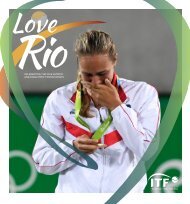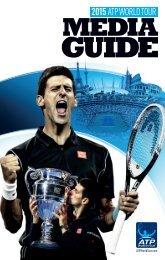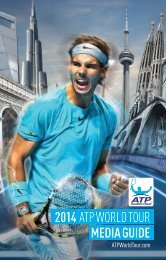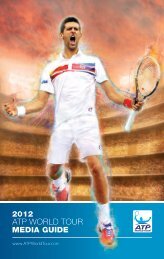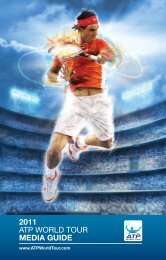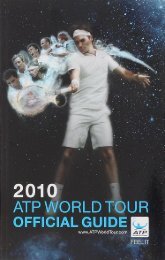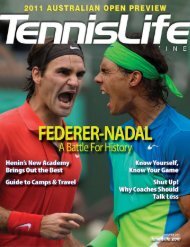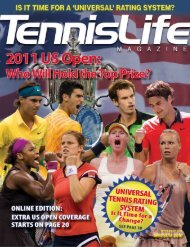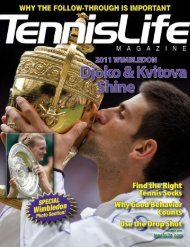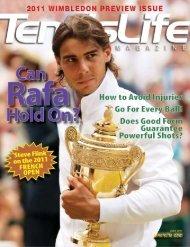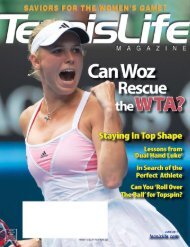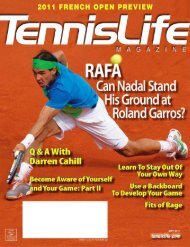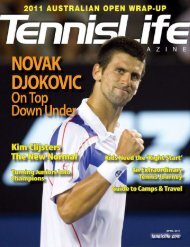A Champion's Mind - Pete Sampras
www.tennismoscow.me Insta:TENNISMOSCOW
www.tennismoscow.me Insta:TENNISMOSCOW
You also want an ePaper? Increase the reach of your titles
YUMPU automatically turns print PDFs into web optimized ePapers that Google loves.
going an extra round or two at some events, can make a big difference, ranking- and money-wise.<br />
Whatever Korda ingested during that period, it didn’t catapult him to the top. He was always in the mix<br />
near the top of the game, and I had struggled with him in the past (four years earlier, he’d beaten me in the<br />
Grand Slam Cup 13–11 in the fifth).<br />
I realize now that doping might have played a role in our U.S. Open encounter (Korda was, after all,<br />
caught less than a year later). It was a long, debilitating match, played under strange conditions, in which<br />
a little extra strength might have provided him with a critical advantage. We’ll never know, because only<br />
Petr knows the truth about what he was—or wasn’t—doing. I bear him no ill will, and just write that loss<br />
off as one of those things.<br />
After that U.S. Open disappointment, I played one of my best Davis Cup matches ever, against a strong,<br />
young Australian team on the hard courts in Rock Creek Park, Washington, D.C. I beat Mark Philippoussis<br />
and Pat Rafter in my two singles to lead the United States into the final against Sweden. We would lose<br />
that final, partly because I had to retire with a leg injury in the middle of my opening match against<br />
Magnus Larsson. I did, however, win the two big year-end events, the Grand Slam Cup and the ATP<br />
World Championships. In the process, I couldn’t help notice that I was seeing more new faces all the time<br />
—guys like Patrick Rafter, Greg Rusedski, and Carlos Moya. . . . I was beginning to feel like a veteran.<br />
I finished as number one for the fifth year in a row in 1997, tying Jimmy Connors’s record. My mission<br />
for the coming year, regardless of my parallel quest to break Roy Emerson’s record for Grand Slam<br />
singles titles (with ten, I trailed him by two at the end of ’97), was to become the only man ever to finish<br />
number one for six years running. Unfortunately, I got off to a pretty slow start.<br />
I had an easy draw at the Australian Open, and didn’t lose a set until the quarters, where I lost a match<br />
I’d just as soon forget to Karol Kucera. A few weeks later, I won just six games off of a resurgent Andre<br />
Agassi in the big indoor tournament in San Jose. In the two major events of the late winter, Indian Wells<br />
and Miami, I took losses from Tomas Muster and Wayne Ferreira, respectively. Both of them were in<br />
early rounds. I had just one tournament win before the tour moved to Europe for the spring, and that was at<br />
my old standby—Philadelphia.<br />
I was picked apart by Fabrice Santoro in the second round at the big Monte Carlo tournament, so I<br />
returned to the States and scooped up a win on the green clay of Atlanta. Green clay, or HAR-T RU, is a<br />
U.S. phenomenon. The loose surface dressing is more granular and slippery than the brick dust of red<br />
clay, so the court plays slightly faster. Along the way, I beat a nice clay-court player from Paraguay,<br />
Ramon Delgado, in two tiebreaker sets. Buoyed by my win, I returned to Europe and got to the third round<br />
of the Italian Open before my countryman Michael Chang sat me down. I felt all right about my game<br />
going to Roland Garros.<br />
I was reasonably confident, and I had a kind draw in Paris, starting with my pal Todd Martin in the first<br />
round. However a match with Todd went, I was always comfortable playing him, and this time I was on<br />
my game and I rolled into the second round in good shape. I found myself up against Delgado, the claycourt<br />
expert I’d beaten handily on clay just a few weeks earlier in Atlanta.<br />
During the match, all of my unresolved issues with clay-court tennis began to play on my mind. Paul sat<br />
by, horrified, as I lost a first-set tiebreaker and then went down winning just seven games over the next<br />
two sets. It wasn’t just that I lost, it was how I lost—I looked like a fish out of water, flopping around in<br />
the dust on the floor of the Philippe Chatrier Court Centrale. I was playing a guy who was barely inside<br />
the top hundred, and who would eventually fall off the ATP computer-ranking chart without ever winning<br />
a singles title (his career record in singles was 94–103). Yet I was the one who played with slumped<br />
shoulders and a lack of fire in my belly. It was one of the most negative performances of my career.<br />
I had survived and overcome difficult moments before, but this time I really recognized that my time in



